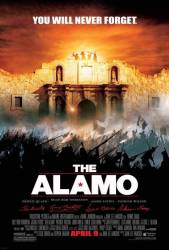Corrected entry: During the last attack, one of the cannons is turned around against the Mexicans that have breached the wall. We see it loaded with canister charge (random pieces of metal) instead of a proper cannonball or grapeshot. When the cannon fires, there are many Mexican troops lying on the ground. Canister charge is a gruesome weapon that causes a cannon to work like a giant shotgun and will reduce a human being to slivers of bloody flesh in an instant - there's no way the Mexicans could avoid being completely butchered. (01:46:30)
Corrected entry: In the scene where the Alamo is in full view, you can see the flagpole is flying an American Banner. In reality, the Texan Army used the Mexican flag, but with the numbers "1824" on it because it wanted the old constitution back that Santa Ana repealed.
Correction: The "Alamo flag" is modern mythology. There is no extant evidence that they actually flew it over the Alamo.
Corrected entry: During the final attack, the Mexicans charge a corner of the fort guarded with wooden stakes set at an angle in the ground. As the Mexicans temporarily fall back, the stakes can be seen wiggling like rubber. Though it could be green wood, no defender would use green wood as a stake intended to stop attackers from charging onto it exactly because it would bend. (01:41:50)
Correction: The wiggling that you see is more reasonably attributed to the natural spring of the wood. A six foot long pike made of juniper or cedar (the most likely woods used, as they are the most abundant trees in this area of Texas which produce branches like these) would spring like this if a grown man or a musket were to strike it like they do in this scene. Also, these pikes would not need to be hard and unbendable, as their purpose is not to stop attackers, but merely to slow a charging line and break it up into single files, which are easier to defend against. For this purpose, they only need a sharp point at the end; if they were still green, it wouldn't matter.
Corrected entry: The first scene of the movie shows stone on the Alamo's wall marked as a calendar of the siege. There are 13 marks on the stone. The final assault takes place before dawn of the 13th day. So, the stone in the first scene should have had only 12 marks.
Correction: It would still be considered the 13th day even though it happened before dawn as long as it happen after 12am.






Correction: The "canister charge," (in this case nails, etc.) poured into the barrel would not tear corpses nor the living apart into shredded flesh any more than a shotgun would.